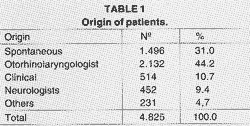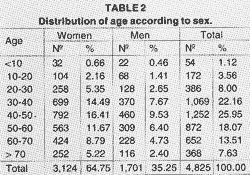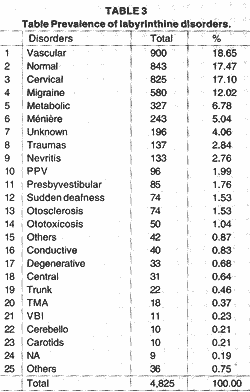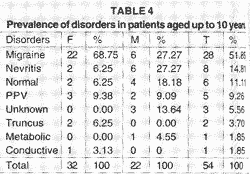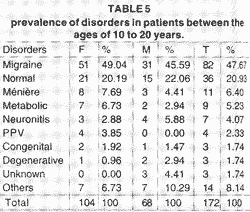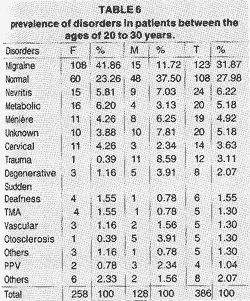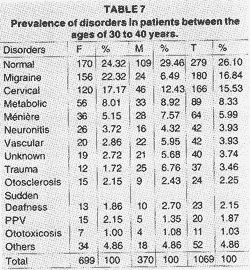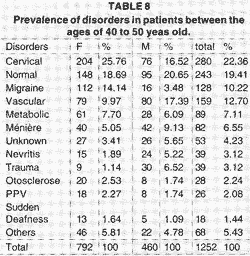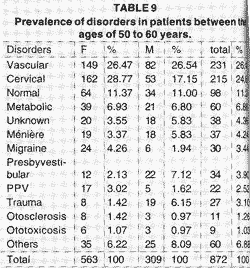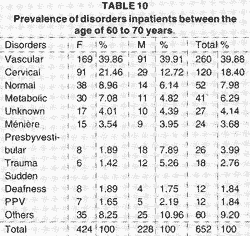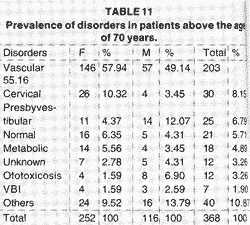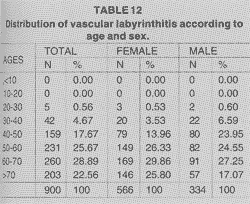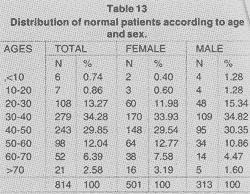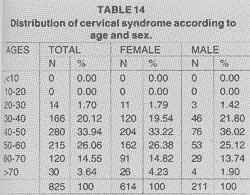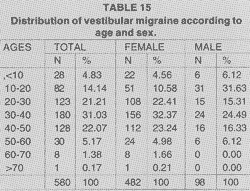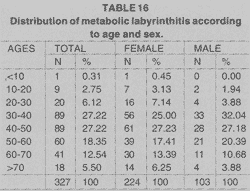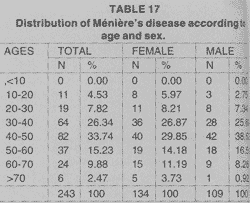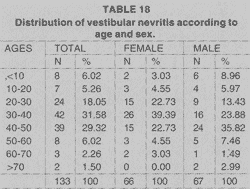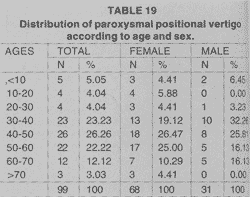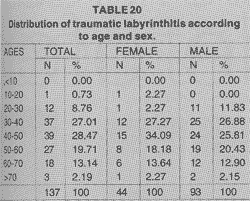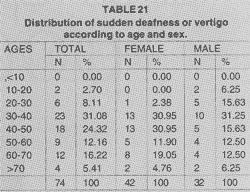

Year: 1999 Vol. 65 Ed. 1 - (3º)
Artigos Originais
Pages: 26 to 33
Prevalence of Vestibular and Cochlear Diseases in 4,825 Patients.
Author(s):
Maudonnet Oscar*,
Gutierrez Francis**;
Maudonnet Eloisa***
Keywords: prevalence, cochlear, vestibular, diseases
Abstract:
A study of the prevalence of vestibulocochlear disorders was conducted on 4,825 patients and it showed that these disorders occurred during middle age and mostly affected women.The most frequent pathologies are vascular labyrinthitis, emotional disturbance and the cervical syndrome. The study also showed that the each disease has a preferential age group, which varies according to the sex.
![]()
INTRODUCTION
Doctor, does my illness occur frequently?
The doctor's answer to this question is based on his professional experience and in many cases it reflects the reality of his background only, and may not be applicable to all cases. There isn't enough-research done on the prevalence of labyrinthine disorders.
lt is a well known fact that there is a high incidence of labyrinthine disorders and especially so in older people. According to Colledge & col. -1994', there is a 30% incidence in- the aged. There are some references in literature on labyrinthine disorders: Conraux & Gentine - 1984² believe that 7% of otoneurological pathologies are due to Mèniére's disease and according to Toupet - 19913 it is 5%. Paroxysmal positional vertigo, which most researchers think is the most common pathology, was found by Misukoshi & col. - 19884 4in 13% to 18% of the patients suffering from vestibulocochlear disorders and Hughes and Proctor - 19975, found it to be 24 %. Nakastiima & col6. -1994, found that suddén deafness occurred in 1% of the cases. Now, Grad & Baloh - 19897, admitted that vascular alterations take place very frequently in vestibular disorders. Nakashima & col. -19968, found this true in 28.8% of therr patients and Gracia & col. - 1996 9, in 11.7% of therr patients.
There are very few references in literature and as some of them are contradictory, we decided to evaluate the prevalence of different pathologies in patients suffering from vestibulocochlear disorders.
METHOD
4,825 patients, who complained of vestibulocochlear disorders and were treated at the Otorhinolaryngological Department of the Facutty of Medical Sciences, UNICAMP, and at our private clinic (Clinic of ENT of Instituto Penido Burnier) during the period March,1994 to February, 1997 (3 years) were evaluated. A period of 6 months was képt between the last evaluation and the compilation of the research results so that the diagnoses could be confirmed as there had been a probable case of sudden deafness that recurred 4 months later accompanied by a crises of vertigo which turned our to be Ménière's disease and another case of vestibular neuritis which months later after a relapse proved to be multiple sclerosis.
All the patients underwent basic tests for a complete otoneurological evaluation and some also underwent tests for potentials that were brought up (BERA). Laboratory and radiological exams were conducted se, as to reach a final diagnosis. The results were evaluated based on the diagnoses, age and sex.
RESULTS AND DISCUSSION
Table 1 is an analysis of the origin of the patients. Ir shows that few of the patients knew that equilibrium disorders are treated by otoneurologists and that many of the patients looked for a cardiologist instead of a neurologist. The very small number of children sent up by pediatricians shows there is lack of information regarding otoneurologic disorders in this area.
Table 2 shows that vestibulocochtear disorders occur more frequently in women - the ratio is 2:1. Contrary to general opinion, these disorders do not affect only the aged but occur more frequently in the forties, followed by the thirties in both men and women. This is contrary to the reports published by Colledge & col.-1994'. These disorders often incapacitate an individual during his most productive phase and as a result there are serious social problems.
While evaluating various pathologies, only 95 main cases (1.96%) were found. However, cases of vestibular migraine which inspire of being main can be considered peripheral, as they are extremely benign, were not computed.
An analysis of Table 3 shows that vascular disorders are the-most frequent-highblood pressure and cardiopathies were a found in 80% of the cases. This is in accordance with the findings 1 of Grad & Baloh - 1989.
Patients, whose examinations results were normal have i equilibrium disorders due to emotional and psychological is disturbances and a high number of these cases shows their I importance.
I Cervical syndrome is a pathology that's on the rise due i to some new professions like typing as well as the bad habit that youngsters have of lying back and watching T. V., keeping the neck in a bent position for many hours.
In children, the classic pulsating headache is not present in most cases of vestibular migraine but the most frequent symptoms are motion-sickness and classic vertigo.
Changes in the sugar metabolism (diabetes and reactive hyperinsulinemia) are responsible for more than 80% of metabolic labyrinthine cases. There are rare cases of increased prolactin, parathyroid disorders etc.. Diagnosis in chronic renal cases is very difficult as most of these patients also have important ototoxic symptoms.
Allergy to food in the case of labyrinthine hydropsy is approximately 20% and respiratory allergies are rare. Other factors had a minimum effect. Most frequently the cause is idiopathic. Classic psychological alterations of this pathology (a tense patient who wants to decide everything at once and is impatient) were present in 95% of the cases. 209 patients (86%) were unilaterally affected.
Most of the incomplete diagnoses were cases forwarded by other doctors but some of them were our patients too. They were patients who required radiological study or blood tests but who never turned up for them. In some cases the diagnosis was not done because the case history was incompatible with the otoneurological findings or the examinations did not confirm the suspicion (normal radiology in the case of a suspicion of nerinoma).
A great majority of the traumas were due to loud noise (industries, dance halls, etc.) and traffic accidents.
It was not possible to correlate equilibrium disorders with previous respiratory infections in most cases of vestibular nevritis. However, it was noted that 93 cases (73%) had the left side compromised and only one cases was bilaterally affected.
Most authors have found paroxysmal positional vertigo as the most frequent vestibular pathology but ín our study it was found to be rare. These data coincide with the studies done by Hughes & Proctor - 19975. who diagnosed 187 cases (24%) of positional vertigo in 781 patients who suffered from vertigo, but on review concluded that only 36 cases (4.6%) were really canalculithiasis while the remaining were vascular disorders and even labyrinthine hydropsy.
Although the above sample is smaller it can be seen that there is a prevalence of vestibular migraine which is in accordance with data provided by Toupet - 199510 in females there is a surprisingly high prevalence of this disorder while ín males it is the same as that of vestibular nevritis.
As the table 4 shows, vestibular migraine is the most important pathology until 10 yers old, followed by vestibular nevritis.
Table 5 shows that vestibular migraine is still the most frequent pathology, however the importance of emotional disorders can be seen that in this group. It is also important to
note that there is a high incidence of Ménière, which according to most authors is usually thought to occur rarely béfore the age of 20.
In rable 6 vestibular migraine is still the most cornmon pathology in table 6, however cases of emotional disorders are also high.
Table 7 shows that the largest number of cases of emotional disorders are in this age group and that they are more than the cases of vestibular migraine. It should also be noted that there is a high incidence of cervical syndrome.
In this age group (Table 8), the incidence of cervical syndrome is the highest, while the incidence of normal patients and cases of vestibular migraine are far less. Vascular disorders now attain an importam level of prevalence.
Table 9 shows that vascular labyrinthitís is more frequent in this age group, followed by the cervical syndrome. There are still many patients suffering from emotional disorders.
Table 10 shows that the incidence of circulatory disorders is very high - 40% vertigo followed by the cervical syndrome. The expected high incidence of vascular labyrinthitis was confirmed by Table 11. 55% of the patients in this age group complained of cochlear vestibulares. The incidence of the cervical syndrome was high but the incidence of presbyvestibular disorders was outstanding
Vascular labyrinthitis (Table 12), as expected, is a pathology of the aged and in both sexes occurs most frequendy in the sixties.
Table 13 shows that the incidence of emotional disorders is highest in the thirties. This reflects the lack of confidence felt at this age,the difficulty in getting a job or in rising professionally. According to Stein & col. -1994"psychological disorders (panic, phobias) are rare.
The highest incidence of cervical syndrome (Table 14) in both sexes is during the forties, when years of bad posture begin taking their toll.
In Table 15 it can be seen that migraines affect men more intensely between the age of 10 to 20 years and this could be due to the emotional instability during puberty, whereas women are more affécted by iigraines during the thirties.
The incidente of metabolic disorders (table 16) is highest in the 30 to 50 years age group anel the cause very often is the alteration in the metabolisrn of sugar (diabetes anel reactive hyperinsulinentnia) - above 75%.
Table 17 shows that the highestincidence of Ménière's disease (Labyrinthine hydropsy) in both sexes is during the forties.
Table 18 shows that the highest incidente of vestibular nevritis is during the thirties. This is contrary to the findings by Sekitani & col. -199312 who concluded that the highest incidente was during the forties. However,in our study this holds true only in the case of males. In only 11% of the cases there was an infection of the upper respiratory tract, a few days before vertigo was felt. This confirms the findings by Hara & col. - 199313
As shown by Table 19, as well by Baloh & Honrubia - 199014 paroxysmal positional vertigo is not benign anel could last for years. Its highest incidente in women is during the forties which is close to the figure found by Baloll & Honrubial14(50 years) anel during the thirties in men. These cata differ greatly from most of the other authors who declared that it was a pathology generally found in the aged (Bloom & col. -198915 )
According to Table 20 it can be seen that trauniatic labyrinthitis affects rnen more intensely during the thirties - traffic accidents or even job accidems, whereas in the case of women it occurs after the age of 40 anel is generally due to physical aggression suffered in the honle.1n the case ofyoung people, the most important cause is the noise in night clubs.
Table 21 shows that the highest incidente of sudden deafness, with or without vertigo, is during the thirties and this confirms the results obtained by Nakashima & col -19948. The audiornetric tests performed on young people indicatedvirotic lesions anel in the case of the aged, vascular lesions. However in the group where the incidente was highest, itwas not possible to have a differential diagnosis in most of the cases.
Important - there should be an awareness of the fact that a varïation of these data can and should be obtained by considering various factors like the region, climate, location of the clinic (private or attached to a large hospital) and the medical habits of each country.
CONCLUSION
1. Women are more affected than men by vestibulocochlear disorders in the proportion 2:1.
2. The age group from 40 to 50 years is most affected, followed by these between 30 to 40 years. Theréfore, this proves that these disorders do not affect only the aged.
3. The most frequent pathologies, placed in order, are: vascular labyrinthítís, psychological and emotional disturbance, cervical syndrome, vestibular migraine, metabolic labyrithitis, Ménière's disease.
4. Each disease affects a particular age group which change according to the sex.
REFERENCES
1. COLLEDGE N, WILSON J, MACINTYRE C & 1VLACLENNAN W. The prevalence and cahracteristics of dizziness in an elderly community. Age-Agein, 23,117-120, 1994.
2. CONRAUX C & GENUNE A - Aspcts semiologiques et evolutifs. Simposium d'ENGde Langue Française, Paris,_ 1984
3. TOUPET M - Livre du Cours de Vestibulométrie Clinique. Ed. Université Louis Pasteur, Strasbourg, 1991.
4. MIZUKOSHI K, WATANABE Y, SHOJAKU H, OKUBO J & WATANABE I - Epidemiological studies on benign paroxysmal positional vertigo in Japan. Acta Otolaryngol, 44 7,67-72, 1988. 5. HUGHES C & PROCTOR L - Benign paroxysmal positional vertigo. Laryngoscope,107, 607-613, 1997.
6. NAKASHIMA T, YANAGITA N, OHNO Y, KANZAKI J & SHITARA T - Comparative study on sudden deafness by two nationwide epidemiological surwey in Japan. Acta Otolaryngol, 514, 14-16, 1994..
7. GRAD A & BALOH R - Vertigo of vascular origin. Clinical and electronystagmographic features in 84 patients. Arch Neurol 46, 281-284, 1989.
8. NAKASHIMA K & col - Prevalence of neurological disorders in a Japanese town. Neuroepidemyology 15, 208-212, 1996.
9. GRACIA-NAYA M, MARTA E, USON M & CAROD J - Estudio epidemiologico descriptivo de una consulta externa de neurologia. Rev Neurol 24, 633-637, 1996
10. TOUPET M - Vertige chez 1'enfant - Encycl. Med. Chir ORL, Paris, 1995.
11. STEIN M, ASMUNDSON G, IRELAND-D& WALKER.I. -Panic disorder in patients attending a clinic for vestibular disorders. Am. J. Psychiatry, 151, 1967-1700, 1994.
12. SEKITANI T, IMATE Y, NOGUCHI T, INOKUMA T. - Vestibular neuronitis: epidemiological survey. Acta Otolaryngol, _503,9-12, 1993.
13. HARA H, SEKITANI T, IMATE Y, INOKUMA T, OKUZONO Y & NISHIKAWA K. - Vestibular neuronitis ín aged patients. Acta Otolaryngol, 503, 53-56, 1993.
14. BALOH R & HONRUBIA V. - Clinical neurophisiology of thevestibularsystem. Davis Company, Philadelphia, 1990. 15. BLOOM J & KATSARKAS A ~J.- Paroxysmal positional v ertigo in the elderly. Otolaryngol., 18, 96-98, 1989.
*Professor of Otoneurology at the State University of Campinas - Brazil, Otoneurologist at the Penido Burnier Institute.
**Voluntary Professor of Otoneurolgy at the State University of Campinas - Brazil.
***2nd Year Resident - Otorhínolaryngology.
Paper presented at XXV NES Congress - Bad Kissingen - Germany. Av. Andrade Neves, 611 - 13013-161 Campinas /SP - Brazil - Telephone: (019) 236-1027 - Fax: (019) 233-1265 - E-mail: omaud.nnnettütltpc.com.br Artigo recebido em 27 de maio de 1998. Artigo aceito em 13 de outubro de 1998.
